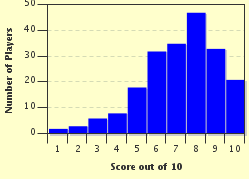Quiz Answer Key and Fun Facts
1. Civil War: The slightly mad Henry VI of House Lancaster and politically shrewd Edward IV of House York engaged in a bit of leapfrogging when it came to the English throne during the War of the Roses. After Edward's death, Richard III of House York (Edward's brother) was briefly king before what event finally ended the Yorkist insurrection?
2. Marriage Alliance: King Ferdinand II and Queen Isabella I became the most influential power couple on the Iberian peninsula when they decided to unite their kingdoms through marriage in the fifteenth century. Later becoming the Kingdom of Spain, which two kingdoms were they?
3. Regicide: Sometimes history repeats itself spectacularly. A proponent of enlightened despotism, Gustav III of Sweden was a king who had taken back his powers from the parliamentarians and nobles of his country in the late 1700s. He was an avid supporter of the arts, so it was somewhat ironic that he was shot with a pistol from behind at what venue after his assassins shouted to him, "Bonjour, beau masque!"?
4. Religious Ostracism: King Ladislaus IV of Hungary was a ruler whose mother was born of a pagan chieftain. With the reach of Christianity spreading into Hungary in the thirteenth century, a papal legate was sent to ensure that Ladislaus convert his pagan Cuman followers. Instead, Ladislaus refused and the papal legate issued what type of Catholic religious censure against the leader?
5. Pretenders to the Throne: The "Time of Troubles" in early seventeenth-century Russia was indeed a troublesome period of time. The cruel, yet formidable Ivan IV (the Terrible) murdered his own son and brought about the end of the Rurik dynasty. Yet, there were a series of three claims by various pretenders to be Ivan's youngest son, who had also been murdered. What was the name these "false" claimants adopted?
6. Religious and Political Expediency: The Protestant Reformation came to a head in France with the House of Bourbon and the House of Guise representing the Huguenots (French Protestants) and Catholics respectively. The ruling house at the time generally supported traditional Catholicism, but was known to appease and switch sides when it was convenient. What was the name of this long-standing, self-serving house?
7. Common Foe: The Union of Krewo in 1385 brought the Kingdom of Poland and the Grand Duchy of Lithuania into a union that was respected for centuries afterward. The union was partly brought about due to what commonly shared religious enemy between the two?
8. Seducing Royalty: In the 1800s, the very worldly Eliza Rosanna Gilbert, also known as Lola Montez, was born in Ireland, became famous for being a "Spanish dancer" while living in France, and was made the Countess of Landsfeld by her lover, King Ludwig I of what German state?
9. Revolt and Secession: The Eighty Years' War is another name for what nation's war of independence from Phillip II of Spain and the Habsburg dynasty?
10. Too Big to Assail: In an attempt to keep Louis XIV of France from continuing his expansionist policies and influencing the Electorate of the Palatinate, the Holy Roman Emperor, Leopold I, created a grand alliance. In addition to the Holy Roman Empire, many nations in the alliance were interested in keeping France at bay including Austria, Spain, the Netherlands, Portugal, Savoy, and Sweden. England and Scotland also joined later.
The alliance was meant to be so large that France dare not attempt to extend its borders. However, France attacked anyway. What was the name of this alliance?
Source: Author
trident
This quiz was reviewed by FunTrivia editor
bloomsby before going online.
Any errors found in FunTrivia content are routinely corrected through our feedback system.

